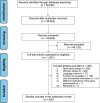Collection of the digital data from the neurological examination
- PMID: 40312534
- PMCID: PMC12046012
- DOI: 10.1038/s41746-025-01659-2
Collection of the digital data from the neurological examination
Erratum in
-
Author Correction: Collection of the digital data from the neurological examination.NPJ Digit Med. 2025 Jul 16;8(1):447. doi: 10.1038/s41746-025-01819-4. NPJ Digit Med. 2025. PMID: 40670653 Free PMC article. No abstract available.
Abstract
This review presents the status quo of how far the digitalization of elements of the neurological examination has progressed. Our focus was on studies that assessed the examination conducted in person, rather than through telemedicine platforms. Five hundred and twenty studies were included in this systematic review. The digital tools covered ten elements of the neurological examination: gait (173, 33%), motor system (149, 29%), eyes (85, 16%), cognitive functions (53, 10%), sensory system (47, 9%), balance (35, 7%), other movements (24, 5%), other cranial nerves (24, 5%), coordination (10, 2%), and autonomic nervous system (9, 2%). Most of the tools were portable (442, 85%), and in 215 studies (41%) the devices were wearable. The cost of the digital tools used was described and discussed in 167 (32%) studies. Most devices (61%) had a low complexity, and half required high additional analytic effort.
© 2025. The Author(s).
Conflict of interest statement
Competing interests: The authors declare no competing interests.
Similar articles
-
Signs and symptoms to determine if a patient presenting in primary care or hospital outpatient settings has COVID-19.Cochrane Database Syst Rev. 2022 May 20;5(5):CD013665. doi: 10.1002/14651858.CD013665.pub3. Cochrane Database Syst Rev. 2022. PMID: 35593186 Free PMC article.
-
Survivor, family and professional experiences of psychosocial interventions for sexual abuse and violence: a qualitative evidence synthesis.Cochrane Database Syst Rev. 2022 Oct 4;10(10):CD013648. doi: 10.1002/14651858.CD013648.pub2. Cochrane Database Syst Rev. 2022. PMID: 36194890 Free PMC article.
-
The educational effects of portfolios on undergraduate student learning: a Best Evidence Medical Education (BEME) systematic review. BEME Guide No. 11.Med Teach. 2009 Apr;31(4):282-98. doi: 10.1080/01421590902889897. Med Teach. 2009. PMID: 19404891
-
Cost-effectiveness of using prognostic information to select women with breast cancer for adjuvant systemic therapy.Health Technol Assess. 2006 Sep;10(34):iii-iv, ix-xi, 1-204. doi: 10.3310/hta10340. Health Technol Assess. 2006. PMID: 16959170
-
Gender differences in the context of interventions for improving health literacy in migrants: a qualitative evidence synthesis.Cochrane Database Syst Rev. 2024 Dec 12;12(12):CD013302. doi: 10.1002/14651858.CD013302.pub2. Cochrane Database Syst Rev. 2024. PMID: 39665382
Cited by
-
Should we digitalize the neurological examination?Neurol Sci. 2025 Aug 9. doi: 10.1007/s10072-025-08398-y. Online ahead of print. Neurol Sci. 2025. PMID: 40782314 No abstract available.
References
-
- The Lancet Digital Health Digital technologies: a new determinant of health. Lancet Digit. Health3, e684 (2021). - PubMed
-
- Rajkomar, A., Dean, J. & Kohane, I. Machine learning in medicine. N. Engl. J. Med.380, 1347–1358 (2019). - PubMed
-
- Vitturi, B. K. & Sanvito, W. L. Pierre Mollaret (1898-1987). J. Neurol.266, 1290–1291 (2019). - PubMed
-
- Williams, G. J. et al. Wearable technology and the cardiovascular system: the future of patient assessment. Lancet Digit. Health5, e467–e476 (2023). - PubMed
LinkOut - more resources
Full Text Sources


